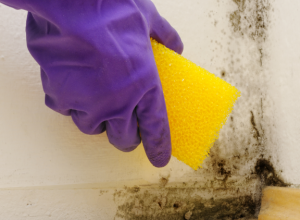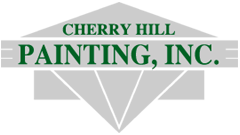Some molds are beneficial, such as Penicillium, which flavors blue cheese and was the first antibiotic! However, most of them are not something we want in our homes, especially if they are growing on the walls. Of course, cleaning is the obvious solution for mold, but what if you wanted to paint anyways; can you paint over mold?
Unfortunately, the problem can’t be dealt with quite that easily. If you paint over mold without properly treating it first, it will continue to grow, posing a hazard to the integrity of your home and the health of your family. So what should you do?
Tips for Dealing with Mold on Walls
 1. Find the water source! Mold grows because of dampness. Is there water seepage in your basement? How about a leak in your roof or around a window? Is there a plumbing leak? Do you have excessive humidity? Whatever the source is, you must have it fixed before you move forward, or you will continue to have worsening problems.
1. Find the water source! Mold grows because of dampness. Is there water seepage in your basement? How about a leak in your roof or around a window? Is there a plumbing leak? Do you have excessive humidity? Whatever the source is, you must have it fixed before you move forward, or you will continue to have worsening problems.
2. Kill it! The best product for killing mold will depend on what type of surface you found it on. Some popular solutions include:
- A mixture of 3 parts water to 1 part bleach
- Undiluted white vinegar
- Foster 40-80
- Concrobium Mold Control
Whichever product you choose, be sure to use it in accordance with the label or instructions. Protect your skin, wear old clothing, and protect any surfaces you don’t want sprayed or dripped on. Then apply a generous amount of the cleaning solution, and let it sit for a while. 10 to 15 minutes would work with the stronger chemicals, or an hour for the vinegar. Then scrub and rinse the area and let it dry.
3. Evaluate the surface. If the mold has a deep hold in a material like drywall, wood, or plaster, you may need to tear it out and replace that area. However, minor residual stains can be covered in the next step.
4. Prime the affected area. Use a strong primer with quality stain-blocking ingredients. Preferably, use one that also has anti-fungal properties, such as Zinsser Mold Killing Primer. This will help to hide the stains, and will also help to prevent a recurrence of the problem.
5. Repaint the wall. It usually doesn’t work very well to repaint just a small area of a wall, since it is unlikely to blend seamlessly with the wall around it. Instead, repaint from one corner to another, so the whole wall is fresh. If you are careful at the corners, you won’t have to paint the other walls, and the lines should be difficult to notice.
Can I Use a Mold-Killing Paint Over Mold?
Unfortunately, paints that are advertised to have mold-killing properties do not have much power to get rid of existing problems. Instead, the benefit they bring is to help prevent the growth of new spots after the application of the paint. You can use a mold-killing paint to good effect after you have disinfected and primed any affected areas.
Interior House Painting In New Jersey
If you live in New Jersey and have any mold on your walls, we would be happy to inspect the problem and help you come up with a good plan to solve it. At Cherry Hill Painting, we provide all kinds of interior house painting services, including cleaning, priming, patching and painting all kinds of surfaces. Please don’t hesitate to contact us!
